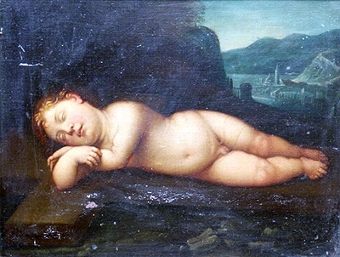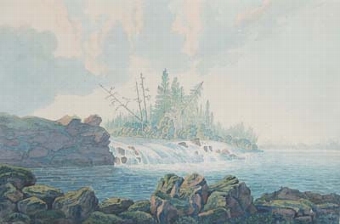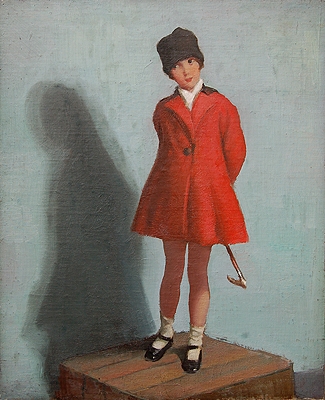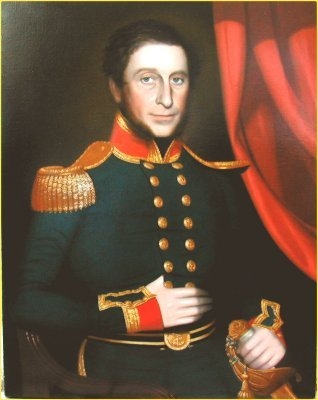portrait of prince albert of saxe-coburg and gotha, the prince consort 1819-1861
- View other items in:
- antiques interior design modern and vintage
- other interior design
artware ltd
Enquire about this antique
Artware Ltd has 565 antiques for sale.
click here to see them all
PAccording to Eugene Barilo von Reisberg, He believes the watercolour was painted after February 1840, when Albert arrived in England, and was made a Field-Marshall (hence he is painted wearing the red Field-Marshall''s uniform), but perhaps before May 1841, when Albert was invested with the Order of the Golden Fleece (you would notice that almost all portraits of Albert after that date show him wearing both Orders of the Garter and of the Golden Fleece). Winterhalter did not arrive in England until June 1842. Hence, it is most likely that this watercolour can be attributed either to Alfred Edward Chalon, John Lucas, or perhaps even George Hayter, who all worked for the Queen and Prince at the time.
However, stylistically, He is more inclined to attribute the work to Albert Edward Chalon, who is recorded to have painted watercolours of Prince Albert in August 1840 (he also painted Queen Victoria between 1838 and 1839; Chalon''s head of Queen Victoria was most famously adapted for the use on British postage stamps).
Prince Albert of Saxe-Coburg and Gotha (in full Francis Charles Augustus Albert Emmanuel), later The Prince Consort, (26 August 1819 ? 14 December 1861) was the husband and consort of Queen Victoria of the United Kingdom of Great Britain and Ireland. He was the only husband of a British queen regnant to have formally held the title of Prince Consort. Upon Queen Victoria''s death in 1901, the House of Saxe-Coburg and Gotha succeeded the House of Hanover on the British throne. The idea of a marriage between Albert and his cousin Victoria had always been cherished by their uncle, King Leopold I of Belgium, as well as Victoria''s mother (Leopold''s sister), the Duchess of Kent, and in May 1836 the Duke of Saxe-Coburg and Gotha and his two sons paid a visit to Kensington Palace, where Princess Victoria of Kent (as she then was titled) lived, for the purpose of meeting her.
The visit did not by any means suit Victoria''s uncle, King William IV, who disapproved of the match with his heir, and favored Prince Alexander, second son of William II of the Netherlands. But Princess Victoria knew of Leopold''s plan, and William''s objections went for naught. Princess Victoria, writing to her uncle Leopold, said that Albert was "extremely handsome" and thanked him for the "prospect of great happiness you have contributed to give me in the person of dear Albert. He possesses every quality that could be desired to render me perfectly happy." The parties undertook no formal engagement, but privately understood the situation as one which would naturally develop in time. After Victoria came to the throne on 20 June 1837, her letters show her interest in Albert''s being educated for the part he would have to play. In the winter of 1838?1839 the prince traveled in Italy, accompanied by the Queen''s confidential adviser, Baron Stockmar.
In October 1839 he and Ernst went again to England to visit the Queen, with the object of finally settling the marriage. Mutual inclination and affection at once brought about the desired result. They became definitely engaged on 15 October 1839 and the Queen made a formal declaration of her intention to marry to the Privy Council on November 23. The couple married on 10 February 1840 at the Chapel Royal, St. James''s Palace. Four days before the wedding, his future wife granted Prince Albert the style of Royal Highness and made him a member of the Privy Council. However the British Prime Minister at the time, Lord Melbourne, advised the Queen against granting her husband the title of "King Consort".Apparently Prince Albert did not wish to become a British peer, unlike Prince George of Denmark, the husband of the future Queen Anne, who was created Duke of Cumberland by King William III in April 1689. He wrote, "It would almost be step downwards, for as a Duke of Saxony, I feel myself much higher than as a Duke of York or Kent." Although he was formally titled "HRH Prince Albert", he was popularly known as "HRH the Prince Consort" for the next seventeen years. On 25 June 1857, Queen Victoria formally granted him the title Prince Consort. The position in which the prince was placed by his marriage, while one of distinguished honour, also offered considerable difficulties; and during his lifetime the tactful way in which he filled it was inadequately appreciated. The public life of the Prince Consort cannot be separated from that of the Queen, so most of what he accomplished was tied to her accomplishments.
Prince Albert, a man of cultured and liberal ideas, proved well qualified to take the lead in many reforms which the United Kingdom of that day sorely needed. He had a special interest in applying science and art to the manufacturing industry. The Great Exhibition of 1851 originated in a suggestion he made at a meeting of the Society of Arts and owed the greater part of its success to his intelligent and unwearied efforts.He had to fight for every stage of the project. In the House of Lords, Lord Brougham denied the right of the crown to hold the exhibition in Hyde Park; in the House of Commons, members prophesied that foreign rogues and revolutionists would overrun England, subvert the morals of the people, filch their trade secrets from them, and destroy their faith and loyalty towards their religion and their sovereign. Prince Albert served as president of the Royal Commission for the Exhibition of 1851, and every post brought him abusive letters, accusing him, as a foreigner, of being intent upon the corruption of England. He was not the man to be balked by talk of this kind and quietly persevered, trusting always that bringing the best manufactured products of foreign countries under the eyes of the mechanics and artisans would improve British manufacturing.
The Queen opened the exhibition on 1 May 1851, and it proved a colossal success. The surplus of 186,000 pounds sterling it raised went to purchase land in South Kensington and establish a number of educational and cultural institutions, including what would later be named the Victoria and Albert Museum. This area of London is sometimes referred to as "Albertopolis". Prince Albert involved himself in promoting many similar, smaller public, educational institutions. Chiefly at meetings in connection with these he found occasion to make the speeches collected and published in 1857. One of his memorable speeches was the inaugural address he delivered as president of the British Association for the Advancement of Science when it met at Aberdeen in 1859. The education of his family and the management of his domestic affairs furnished the prince with another very important sphere of action, in which he employed himself with conscientious devotion. The estates of the Duchy of Cornwall, the hereditary property of his son, the Prince of Wales, improved so greatly under his father''s management that the rent receipts rose from 11,000 pounds to 50,000 pounds per year. Prince Albert, indeed, had a peculiar talent for the management of landed estates. His model farm at Windsor was in every way worthy of the name; and he designed the layout of the grounds at Balmoral and Osborne. As the prince became better known, public mistrust began to give way. In 1847, but only after a significantly keen contest with Earl Powis, he was elected chancellor of the University of Cambridge; and he was afterwards appointed master of Trinity House. In June 1857 the formal title of Prince Consort was conferred upon him by letters patent, in order to settle certain difficulties as to precedence that had arisen at foreign courts. But in the full career of his usefulness he was cut off. In 1861 when the Trent Affair threatened war between the United States and Britain, Albert intervened quietly to soften the British diplomatic response. During the autumn of 1861 he was busy with the arrangements for the projected international exhibition, and it was just after returning from one of the meetings in connection with it that he was seized with his last illness. Beginning at the end of November with what appeared to be influenza, it proved to be an attack of typhoid fever, and, congestion of the lungs supervening, he died on 14 December.The Queen''s grief was overwhelming, and the sympathy of the whole nation erased the tepid feelings the public had for him during his lifetime. Queen Victoria wore mourning for him for the rest of her long life. Nonetheless, he was thought to have undue influence in politics, and the prejudice against him never fully dissipated until after his death.
Alfred Chalon was born in Geneva from a father who soon was hired as professor at the Royal Military Academy Sandhurst, in England. With his brother John James (1778-1854), Alfred became an artist. Entered at the Royal Academy in 1797, he joined the Associated Artists in Water-Colours, a group of aquarellists. In the Academy, he was elected associated in 1812, then academician in 1816. Known for his portraits of the good society of London, he was chosen by Queen Victoria to paint a gift to her mother: Victoria in her State robes going to the House of Lords for her first official act, the prorogation of the Parliament, on 17 July 1847. After this task, Chalon was entitled Portrait Painter in Water Colour to Her Majesty and gained some celebrity. His 1847 portrait was engraved by Samuel Cousins and distributed to the public the day of Victoria''s coronation, the 28 June 1848. Then, starting in 1851, the "Chalon head" appeared on some British colonies postage stamps. Bachelors, the Chalon brothers lived together. Alfred died in 1860 at Campden Hill, in Kensington.
Antiques.co.uk Ref: RAM5RRDN
- Materials:
- Pencil and Watercolour
- Width (cm):
- 31.00 x 24.00 cm 12.20 x 9.45 ins
Artware Ltd
Artware Fine Art specialises in fine antique, decorative and historical portraits and topographical pictures . We cover a period from the 17th and 18th centuries through to the 19th & 20th Centuries. We have over 150 portraits in stock, which can be viewed on our web site, each historical portrait has well researched biographical information both on the sitter and the artist.
Contact details
18 La gare
51 Surrey row
London
Greater London
SE1 0BZ
UNITED KINGDOM
T: 0207 921 97904
E: greg@artwarefineart.com
W: www.artwarefineart.com














